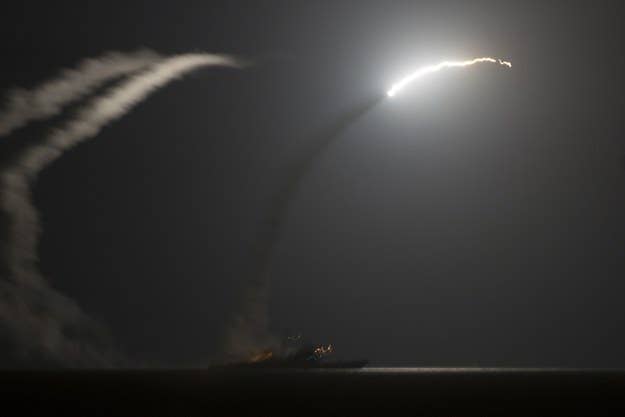
WASHINGTON — An Al-Qaeda-connected group that the Obama administration has targeted with airstrikes alongside ISIS was almost totally unknown to the American public until the U.S. started bombing them, though sources say the group has been known to the administration and to Congress for some time.
The U.S. claims that Khorasan, an Al-Qaeda-linked terrorist group said to be led by an operative named Muhsin al-Fadhli, was a direct threat to the U.S homeland. Little is known about al-Fadhli, though the Department of State says he was based in Iran. But hardly any public information was available about the group before this week and some are suggesting the Khorasan group is simply a renaming of already-known Al-Qaeda operatives in Syria.
That started to change in the last week, as stories about Khorasan began appearing in the media. U.S. officials have described the group as being part of Jabhat al-Nusra, an Al-Qaeda affiliate in Syria fighting both Syrian President Bashar al-Assad's forces as well as ISIS.
According to a source familiar with the situation, U.S. officials have been aware of Khorasan for months. And Rep. Peter King, the former Homeland Security Committee chair, said that members of Congress have "known about it for several months."
"I'm surprised it [the name] even came out," King said. "It was supposed to be top secret, classified, and it wasn't until last week that an AP story had it in there. But we weren't supposed to talk about it."
"The intelligence community has known about it ... [Khorasan] are extremely lethal and dangerous," King said.
Rep. Adam Schiff, a Democratic member of the House Permanent Select Committee on Intelligence, said "we have been briefed on the Khorasan group for some time."
"I knew about the group a year ago from the media but didn't know the name or personalities until the past few days--again from the media," said Will McCants, a terrorism analyst and fellow at the Brookings Institution.
An Amnesty International report on drones in Pakistan from October 2013 refers to an "al-Qa'ida-linked outfit" called Mujahideen Khorasan, but is unclear if it's the same Khorasan. A source that was briefed on Khorasan in June said that the counterterrorism community believes that between 10 and 20 top Al Qaeda people had gone to Syria from Waziristan "to link up in Syria and establish a new AQ affiliate in Syria that would be focused on training and deploying against the West."
"The group has been referred to elliptically in open-source reporting for several months now," said Daveed Gartenstein-Ross, a counter-terrorism analyst at the Foundation for Defense of Democracies. Gartenstein-Ross said that the composition and size of the group is still unclear, though: "At the very least, number one, it's embedded with Jabhat al-Nusra but it's a separate organization from Nusra." The name, he said, "has particular eschatological meanings related to jihadist views of the end times."
Gartenstein-Ross said there could be more information coming out about other aspects of Khorasan: "It's possible that information that's coming out about the Khorasan shura [or council of leaders] is about its operational wing rather than information abut the entirety of the group. It certainly seems it's more than just an external operations capability."
The group, he said, appears to be connected to Ibrahim al-Asiri, the bomb maker for Al-Qaeda in the Arabian Peninsula who was connected to the underwear bomber.
Both Gartenstein-Ross and Mustafa Alani, Senior Advisor and Program Director in Security and Terrorism Studies at the Gulf Research Center, were skeptical of Al-Fadhli's reported role. "I'm not sure the information is accurate," Alani said. "Muhsih Al Fadlhi is not the quality of the leader you'd see. He's not a commander, not a field commander. He's more a preacher then a commander."
Aaron Zelin, an expert on extremist groups at the Washington Institute, said there was "no difference" between Khorasan and Jabhat al-Nusra.
"They are AQ members dispatched by Zawahiri that were based in AfPak or Iran to Syria to build up JN's external operations capabilities since there's more operational space and closer to the West," Zelin said. He said there were reports about Khorasan going back "at least 6-18 months."
Zelin said he thought the reports of a Khorasan threat against the U.S. were credible: "It's AQ so I don't see why they wouldn't want to try and plan [operations] from Syria."
Some are doubting the credibility of the threat, arguing that the Obama administration has exaggerated it to justify bombing Syria.
"I think the USG is blowing them [Khorasan] way out of proportion," said a congressional aide who focuses on Syria. "They need a good story right now and saying they subverted a terrorist plot against America is good press."
Obama himself has never publicly mentioned Khorasan until Tuesday, when the U.S. had already bombed them.
"Myself and some others are wondering why this suddenly appeared last week, why this leaked out after being kept so secret," said a Republican congressman familiar with Khorasan. "It could be that they wanted a good reason why we attacked them in Syria. We are saying they are a threat to the US so they obviously wanted that out there before we attacked that."
Kate Nocera, John Stanton, Aram Roston and Mike Giglio contributed reporting.
